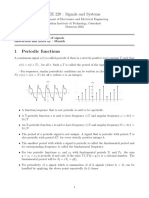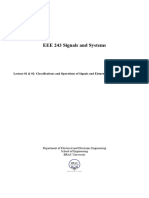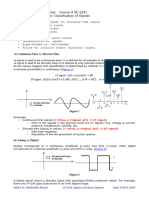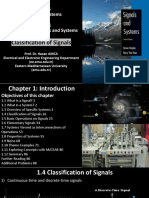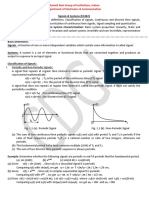Model of a Communication System
Communication is defined as “exchange of information“.
Telecommunication refers to communication over a distance greater than would normally
be possible without artificial aids.
Telephony is an example of point-to-point communication and normally involves a two –
way flow of information.
Broadcast radio and television : Information is transmitted from one location but is
received at many locations using different receivers (point to multi-point communication)
Model of a communication system :
Modulated signal y(t)
Information source Transmitter Communication
and input transducer Channel
Message signal 𝑥(𝑡) y'(t) + n(t)
Output transducer Receiver
∑
and destination
Output signal 𝑥̂(𝑡) Noise n(t)
The purpose of a communication system is to transmit information – bearing signals from
a source located at one point to a user located at another end.
The input transducer is used to convert the physical message generated by the source into
a time-varying electrical signal called the message signal.
The original message is recreated at the destination using an output transducer.
The transmitter modifies the message signal into a form suitable for transmission over
the channel. Here modulation takes place.
The channel is the medium over which signal is transmitted, (like free space, an optical
fiber, transmission lines, twisted pair of wires…). Here signal is distorted due to
A. Nonlinearities and/or imperfections in the frequency response of the channel.
B. Noise and interference are added to the signal during the course of transmission.
The purpose of the receiver is to recreate the original signal x(t) from the degraded
version x(t) + n(t) of the transmitted signal after propagating through channel .
Here, demodulation takes place.
1
� Classification of Signals
Definition: A signal may be defined as a single valued function of time that conveys
information.
Depending on the feature of interest, we may distinguish four different classes of signals:
1. Periodic Signals, Non-periodic Signals:
A periodic signal g(t) is a function of time that satisfies the condition g(t) = g(t+T0), ∀t.
The smallest value of T0 that satisfies this condition is called the period of g(t).
Example: A Periodic Signal
The saw-tooth function shown below is an example of a periodic signal.
Example: A Non-periodic Signal
The signal
𝐴, 0 ≤ 𝑡 ≤ 𝜏
𝑔(𝑡) = {
0, 𝑜𝑡ℎ𝑒𝑟𝑤𝑖𝑠𝑒
is non-periodic, since there does not exist a T0 for which the condition g(t) = g(t+T0) is satisfied.
2. Deterministic Signals, Random Signals:
A deterministic signal is one about which there is no uncertainty with respect to its value at any
time. It is a completely specified function of time .
Example: A Deterministic Signal
x(t) = 𝐴𝑒 −𝑎𝑡 u(t) ; 𝐴 and α are constants.
2
�A random signal is one about which there is some degree of uncertainty before it actually occurs.
(It is a function of a random variable )
Example : A Random Signal
x(t) = A 𝑒 −𝑎𝑡 u(t) ; α is a constant and A is a random variable with the following probability density
function (pdf).
FA(a) = { 1 0≤𝑎≤1
0 𝑜𝑡ℎ𝑒𝑟𝑤𝑖𝑠𝑒
3. Energy Signals, Power Signals:
The instantaneous power in a signal g(t) is defined as that power dissipated in a 1-Ω resistor, i.e.,
p(t) = |g(t)|2
The average power is defined as:
1 𝑇
Pav≜ lim 2𝑇 ∫−𝑇 |𝑔(𝑡)|2 𝑑𝑡
𝑇→∞
The total energy of a signal g(t) is
𝑇
E≜ lim ∫−𝑇 |𝑔(𝑡)|2 𝑑𝑡
𝑇→∞
A signal g(t) is classified as energy signal if it has a finite energy,i.e, 0 < E < ∞
A signal g(t) is classified as power signal if it has a finite power,i.e, 0 < Pav< ∞
The average power in a periodic signal is
1 𝑇
Pav= 𝑇 ∫0 0 |𝑔(𝑡)|2 𝑑𝑡 ; T0 is the period;
0
𝑓0 = 1/𝑇0 is referred to as the fundamental frequency
Usually, periodic signals and random signals are power signals. Both deterministic and non
periodic signals are energy signals (We will show a counterexample shortly).
4. Analog Signals, Digital Signals :
An analog signal is a continuous time - continuous amplitude function of time .
Example:
The sinusoidal signalx(t) = Acos 2𝜋𝑓𝑡 , −∞ < 𝑡 < ∞, is an example of an analog signal.
3
�A discrete time- discrete amplitude(digital) signal is defined only at discrete times. Here, the
independent variable takes on only discrete values.
Example:
The sequence x[n] shown below is an examples of a digital signal. The amplitudes are drawn from
the finite set {1,0,2}.
More Examples
Example: The Exponential Pulse
Find the energy in the signal g(t) = A 𝑒 −∝𝑡 u(t).
∞ −𝑒 −2∝𝑡 ∞ 𝐴2
E= ∫0 𝐴2 𝑒 −2∝𝑡 𝑑𝑡 = 𝐴2 0| = . Since E is finite, then g(t) is an energy signal.
2∝ 2∝
Example: The Rectangular Pulse
Find the energy in the signal:
𝐴, 0<𝑡<𝜏
𝑔(𝑡) = {
0, 𝑜. 𝑤
𝜏
E= ∫0 𝐴2 𝑑𝑡 = 𝐴2 𝜏. This signal is an energy since E is finite.
Example: The Periodic Sinusoidal Signal
Find the average power in the signal :
g(t) = A cos 𝜔𝑡 , −∞ < 𝑡 < ∞
Since g(t) is periodic, then :
4
� 1 𝑇 𝐴2 𝑇 1+cos 2𝜔𝑡 𝐴2 𝑇0 𝐴2
Pav = 𝑇 ∫0 0 𝐴2 cos2 𝜔𝑡 𝑑𝑡 = 𝑇 ∫0 0( 2
)= 𝑇0
. 2
=2 .
0 0
Here, Pav is finite and, therefore, g(t) is a power signal.
Example: The Periodic Saw-tooth Signal
Find the average power in the saw-tooth signal g(t) plotted in Fig.1.
𝐴
g(t) = 𝑇 t , 0≤ 𝑡 ≤ 𝑇0
0
1 𝑇 𝐴2 1 𝐴2 𝑡 3 𝑇0 𝐴2 𝑇0 3 𝐴2
Pav = 𝑇 ∫0 0 𝑇 2 𝑡 2 𝑑𝑡 = | = = .
0 0 𝑇0 𝑇0 2 3 0 3 𝑇0 3
3
Example: The Unit Step Function
Consider the signal: g(t) = A u(t).
g(t)
-T 0 T
Fig. 1.2
This is a non periodic signal. So let us first try to find its energy:
∞ 2
E = ∫0 𝐴 𝑑𝑡 = ∞ .
Sine E is not finite, then g(t) is not an energy signal.
To find the average power, we employ the definition :
1 𝑇 2
Pav ≜ 𝑇→∞
lim 2𝑇 ∫−𝑇 |𝑔(𝑡)| 𝑑𝑡,
where 2T is chosen to be a symmetrical interval about the origin, as in Fig. 1.2 above.
1 𝑇 𝐴2 𝑇 𝐴2
Pav = lim 2𝑇 ∫0 𝐴2 𝑑𝑡 = lim = .
𝑇→∞ 𝑇→∞ 2𝑇 2
So, even-though g(t) is non-periodic, it turns out that it is a power signal.
Remark: This is an example where the general rule (periodic signals are power signals and energy
signals are non periodic signals) fails to hold.
5
� Fourier Series
1
Let g(t) be a periodic signal with period T0 =𝑓 such that it absolutely integrable over one period,
0
𝑇0
i.e., ∫0 |𝑔(𝑡)| 𝑑𝑡 < ∞.
The signal g(t), satisfying the above integrability condition, may be expanded in one of three
possible Fourier series forms (We will not address the question of series convergence in this
discussion):
The complex form:
∞
𝑔(𝑡) = ∑𝑛=−∞ Cn ejnω0t
1 𝑇
where, Cn = 𝑇 ∫0 0 𝑔(𝑡) 𝑒 −𝑗𝑛𝜔0 𝑡 𝑑𝑡 ;
0
Cn : is a complex valued quantity that can be written as:
Cn = | Cn | 𝑒 𝑗𝜃𝑛
Discrete Amplitude Spectrum: A plot of |Cn| vs. frequency
Discrete Phase Spectrum: A plot of 𝜃𝑛 vs. frequency
The term at 𝑓0 is referred to as the fundamental frequency. The term at 2𝑓0 is referred to as the
second order harmonic, and so on.
The trigonometric form:
∞
𝑔(𝑡) = 𝑎0 + ∑(𝑎𝑛 cos 𝑛𝜔0 𝑡 + 𝑏𝑛 sin 𝑛𝜔0 𝑡)
𝑛=1
1 𝑇
Where : 𝑎0 = 𝑇 ∫0 0 𝑔(𝑡) 𝑑𝑡 (dc or average value)
0
2 𝑇
𝑎𝑛 = ∫0 0 𝑔(𝑡) cos 𝑛𝜔0 𝑡 𝑑𝑡
𝑇0
𝑇0
2
𝑏𝑛 = ∫ 𝑔(𝑡) sin 𝑛𝜔0 𝑡 𝑑𝑡
𝑇0
0
The polar form :
∞
𝑔(𝑡) = 𝑐0 + ∑ 2|Cn | cos(𝑛𝜔0 𝑡 + 𝜃𝑛 )
𝑛=1
6
�where Cn and 𝜃𝑛 are those terms defined in the complex form.
Remark: The above three forms are equivalent and are representations of the same waveform. If
you know one representation, you can easily deduce the other.
Example: Find the trigonometric Fourier series of the periodic rectangular signal defined over
one period 𝑇0 as:
+𝐴, −𝑇0 /4 ≤ 𝑡 ≤ 𝑇0 /4
𝑔(𝑡) = {
0, 𝑜𝑡ℎ𝑒𝑟𝑤𝑖𝑠𝑒
Solution:
1 𝑇 /2 1 𝑇 /4
𝑎0 = 𝑇 ∫−𝑇0 /2 𝑔(𝑡) 𝑑𝑡 = 𝑇 ∫−𝑇0 /4 𝐴 𝑑𝑡 = 𝐴/2
0 0 0 0
2 𝑇 /2 2𝜋𝑛 2 𝑇 /4 2𝜋𝑛
𝑏𝑛 = 𝑇 ∫−𝑇0 /2 𝑔(𝑡) sin( 𝑡) 𝑑𝑡 = 𝑇 ∫−𝑇0 /4 𝐴 sin( 𝑡) 𝑑𝑡 = 0
0 0 𝑇0 0 0 𝑇0
2 𝑇 /2 2𝜋𝑛 2 𝑇 /4 2𝜋𝑛
𝑎𝑛 = 𝑇 ∫−𝑇0 /2 𝑔(𝑡) cos( 𝑡) 𝑑𝑡 = 𝑇 ∫−𝑇0 /4 𝐴 cos( 𝑡) 𝑑𝑡
0 0 𝑇0 0 0 𝑇0
2𝐴
, 𝑛 = 1, 5, 9, …
𝑛𝜋
𝑎𝑛 = −2𝐴
, 𝑛 = 3, 7, 11, …
𝑛𝜋
{ 0, 𝑛 = 2, 4, 6 …
The first four terms in the expansion of 𝑔(𝑡) are:
𝐴 2𝐴 1 1
𝑔̃(𝑡) = + {cos(2𝜋𝑓0 ) 𝑡 − cos(2𝜋3𝑓0 ) 𝑡 + cos(2𝜋5𝑓0 ) 𝑡}
2 𝜋 3 5
The function 𝑔̃(𝑡) along with 𝑔(𝑡) are plotted in the figure for −1 ≤ 𝑡 ≤ 1 assuming 𝐴 = 1 and
𝑓0 = 1
7
�Remark: As more terms are added to 𝑔̃(𝑡), 𝑔̃(𝑡) becomes closer to 𝑔(𝑡) and in the limit as 𝑛 →
∞, 𝑔̃(𝑡) becomes equal to 𝑔(𝑡) at all points except at the points of discontinuity.
Parseval’s Power Theorem
The average power of a periodic signal g(t) is given by:
1 𝑇 ∞ ∞
Pav = 𝑇 ∫0 0|𝑔(𝑡)|2 𝑑𝑡 = ∑𝑛=−∞|Cn |2 = |Cn |2 + 2∑𝑛=1|Cn |2
0
1 ∞
= |𝑎0 |2 + 2 ∑𝑛=1(|𝑎𝑛 |2 + |𝑏𝑛 |2)
Power Spectral Density
The plot of |Cn |2 versus frequency is called the power spectral density (PSD). It displays the
power content of each frequency (spectral) component of a signal. For a periodic signal, the PSD
consists of discrete terms at multiples of the fundamental frequency.
Exercise: Consider again the saw-tooth function defined over one period as 𝑔(𝑡) = 𝑡, 0 ≤ 𝑡 ≤ 1
a. Use matlab to find the dc terms and the first three harmonics(i.e., let n = 3) in the Fourier
series expansion
3
𝑔̃(𝑡) = 𝑎0 + ∑(𝑎𝑛 cos 𝑛𝜔0 𝑡 + 𝑏𝑛 sin 𝑛𝜔0 𝑡)
𝑛=1
b. Plot 𝑔̃(𝑡) and 𝑔(𝑡) versus time for −1 ≤ 𝑡 ≤ 1 on the same graph.
c. Find the fraction of the power contained in 𝑔̃(𝑡) to that in 𝑔(𝑡).
d. Sketch the power spectral density.
8
�Example :Find the power spectral density of the periodic function g(t) shown in the figure :
Solution: Here, we need to find the complex Fourier series expansion, where the period T0 = 2𝜏
∞ 1 𝑇
𝑔(𝑡) = ∑𝑛=−∞ Cn ejnω0t ; Cn =𝑇 ∫0 0 𝑔(𝑡) 𝑒 −𝑗𝑛𝜔0 𝑡 𝑑𝑡
0
𝐴
, 𝑛=0 𝐴
2
3𝐴 ( 2 )2 , 𝑛=0
, 𝑛 = ±1, ±5, ±9, …
Cn = |𝑛|𝜋 |Cn |2 = { (3𝐴 )2 , 𝑛: 𝑜𝑑𝑑
−3𝐴 𝑛𝜋
, 𝑛 = ±3, ±7, ±11, …
|𝑛|𝜋 0, 𝑛: 𝑒𝑣𝑒𝑛
{ 0, 𝑛 = ±2, ±4, …
∞
𝑆𝑔 (𝑓) = ∑ |Cn |2 δ(f − nf0 )
𝑛=−∞
As can be seen, the power spectral density of this periodic signal is a discrete function in
frequency.
Exercise: Verify Parseval’s power theorem for this signal, i.e., show that
1 𝑇 ∞
𝑃𝑎𝑣 = 𝑇 ∫0 0|𝑔(𝑡)|2 𝑑𝑡 = ∑𝑛=−∞|Cn |2 = 2.5𝐴2
0
9
� Fourier Transform
Let g(t) be a non periodic square integrable function of time. That is one for which
∞
∫−∞ |𝑔(𝑡)|2 𝑑𝑡<∞
The Fourier transform of g(t) exists and is defined as:
∞
𝐺(𝑓) = ∫ 𝑔(𝑡)𝑒 −𝑗2𝜋𝑓𝑡 𝑑𝑡
−∞
The time function g(t) can be recovered from 𝐺(𝑓) using the inverse Fourier Transform:
∞
𝑔(𝑡) = ∫ 𝐺(𝑓)𝑒 𝑗2𝜋𝑓𝑡 𝑑𝑓
−∞
Remarks:
∞
All energy signals for which𝐸 = ∫−∞ |𝑔(𝑡)|2 𝑑𝑡<∞ are Fourier transformable.
G(f) is a complex function of frequency f, which can be expressed as:
G(f) = | G(f) | 𝑒 𝑗𝜃(𝑓)
where, | G(f) | : is the continuous amplitude spectrum of g(t), (even function of f).
𝜃(𝑓) : is the continuous phase spectrum of g(t), (odd function of f).
Rayleigh Energy Theorem :
The energy in a signal g(t) is given by :
∞ ∞
E = ∫−∞ |𝑔(𝑡)|2 𝑑𝑡 = ∫−∞ |𝐺(𝑓)|2𝑑𝑓
The function |𝐺(𝑓)|2 is called the energy spectral density. It illustrates the range of frequencies
over which the signal energy extends and the frequency bands which are significant in terms of
their energy contents. For a non-period signal energy signal, the energy spectral density is a
continuous function of f.
A General Form of the Rayleigh Energy Theorem
For two energy functions g(t) and 𝑣(𝑡), the following result holds:
10
� ∞ ∞
∫−∞ 𝑔(𝑡)𝑣(𝑡)∗ 𝑑𝑡= ∫−∞ 𝐺(𝑓)𝑉(𝑓)∗ 𝑑𝑓
Example: Energy spectral density of the exponential signal
−𝑏𝑡
𝑣(𝑡) = {𝐴 𝑒 𝑡>0
0 𝑡<0
∞ ∞
−𝑗2𝜋𝑓𝑡
𝑉(𝑓) = ∫ 𝑣(𝑡)𝑒 𝑑𝑡 = ∫ 𝐴𝑒 −𝑏𝑡 𝑒 −𝑗2𝜋𝑓𝑡 𝑑𝑡
0 0
∞ 𝑒 −(𝑏+𝑗2𝜋𝑓)𝑡 ∞ 𝐴
𝑉(𝑓) = 𝐴 ∫0 𝑒 −(𝑏+𝑗2𝜋𝑓)𝑡 𝑑𝑡 = A | = 𝑏+𝑗2𝜋𝑓 .
−(𝑏+𝑗2𝜋𝑓) 0
𝐴 𝐴
𝑉(𝑓) = 𝑏+𝑗2𝜋𝑓 |𝑉(𝑓)| = (𝑏2 +(2𝜋𝑓)2 )1/2
𝐴2
The energy spectral density is: 𝑆𝑣 (𝑓) = |𝑉(𝑓)|2 = 𝑏2 +𝜔2
Remark: The signal 𝑣(𝑡) is called a baseband signal since the signal occupies the low frequency
part of the spectrum. That is, the energy in the signal is found around the zero frequency. When
the signal is multiplied by a high frequency carrier, the spectrum becomes centered around the
carrier and the modulated signal is called a bandpass signal.
Exercise : For the exponential pulse, verify Rayleigh energy theorem, i.e., show that
∞ ∞ 𝐴2
∫0 |𝑣(𝑡)|2 𝑑𝑡 = 2 ∫0 |𝑉(𝑓)|2 𝑑𝑓 = 2𝑏.
𝑡
Example: The Rectangular Pulse 𝑔(𝑡) = 𝐴𝑟𝑒𝑐𝑡(𝑇)
𝑇/2 𝐴
𝐺(𝑓) = ∫−𝑇/2 𝐴𝑒 −𝑗2𝜋𝑓𝑡 𝑑𝑡 = sin 𝜋𝑓𝑇
𝜋𝑓
sin 𝜋𝑓𝑇
= A𝑇 𝜋𝑓𝑇 ≜ 𝐴𝑇 𝑠𝑖𝑛𝑐 𝑇𝑓
|𝐺(𝑓)| = 𝐴𝑇 |𝑠𝑖𝑛𝑐 𝑇𝑓|
sin 𝑥
lim =1 max. of function
𝑥→0 𝑥
𝐺(𝑓) = 0 𝑤ℎ𝑒𝑛 𝑠𝑖𝑛 (𝜋𝑓𝑇) = 0 or 𝑤ℎ𝑒𝑛 𝜋𝑓𝑇 = 𝑛𝜋 , n=±1, ±2, ±3,…
11
� 𝑛
𝑓𝑇 = 𝑛, ∴ 𝑓 =
𝑇
Remark: Time duration and bandwidth :
1
Note that as the signal time duration 𝑇 𝑖𝑛𝑐𝑟𝑒𝑎𝑠𝑒𝑠, the first zero crossing at 𝑓 = 𝑇 decreases,
implying that the bandwidth of the signal decreases. More on this will be said later when we
discuss the time bandwidth product.
𝑡
Exercise : For the rectangular pulse 𝑔(𝑡) = 𝐴𝑟𝑒𝑐𝑡(𝑇), verify Rayleigh energy theorem, i.e.,
show that
∞ ∞
∫0 |𝑔(𝑡)|2 𝑑𝑡 = 2 ∫0 |𝐺(𝑓)|2 𝑑𝑓 = 𝐴2 𝑇.
12
�Properties of the Fourier Transform:
1. Linearity (superposition)
Let 𝑔1 (𝑡) ↔ 𝐺1 (f)
and 𝑔2 (𝑡) ↔ 𝐺2 (f) , then
𝑐1 𝑔1 (𝑡)+𝑐2 𝑔2 (𝑡) ↔ 𝑐1 𝐺1 (𝑓)+𝑐2 𝐺2 (𝑓) ; 𝑐1 , 𝑐2 are constants
2. Time scaling
If 𝑔1 (𝑡) ↔ 𝐺1 (f),
then
1
𝑔(𝑎𝑡) ↔ 𝐺(𝑓⁄𝑎)
|𝑎|
3. Duality
If 𝑔(𝑡) ↔ 𝐺(𝑓) ,
Then, 𝐺(𝑡) ↔ 𝑔(−𝑓)
4. Time shifting
If 𝑔(𝑡) ↔ 𝐺(𝑓)
then 𝑔(𝑡 − 𝑡0 ) ↔ 𝐺(𝑓)𝑒 −𝑗2𝜋𝑓𝑡0
Delay in time domain phase shift in frequency domain
5. Frequency shifting
If 𝑔(𝑡) ↔ 𝐺(𝑓) ,
then 𝑔(𝑡)𝑒 𝑗2𝜋𝑓𝑐𝑡 ↔ 𝐺(𝑓 − 𝑓𝑐) ; fc is a real constant
6. Area under 𝐺(𝑓)
If 𝑔(𝑡) ↔ 𝐺(𝑓) ,
∞
then: 𝑔(𝑡 = 0) = ∫−∞ 𝐺(𝑓)𝑑𝑓
The value 𝑔(𝑡 = 0) is equal to the area under its Fourier transform.
7. Area under 𝑔(𝑡)
If 𝑔(𝑡) ↔ 𝐺(𝑓)
13
� ∞
Then, 𝐺(0) = ∫−∞ 𝑔(𝑡)𝑑𝑡
The area under a function g(t) is equal to the value of its Fourier transform G(f) at f = 0,
where 𝐺(0) implies the presence of a dc component.
8. Differentiation in the time domain
If 𝑔(𝑡) and its derivative 𝑔′(𝑡) are Fourier transformable, then,
𝑔′(𝑡) ↔ (𝑗2𝜋𝑓)𝐺(𝑓)
i.e., differentiation in the time domain multiplication by j2𝜋𝑓 in the frequency domain.
(differentiation in the time domain enhances high frequency components of a signal)
𝑑𝑛 𝑔(𝑡)
Also, ↔ (𝑗2𝜋𝑓)𝑛 𝐺(𝑓)
𝑑𝑡 𝑛
9. Integration in the time domain
𝑡 1
∫−∞ 𝑔(𝜏)𝑑𝜏 ↔ 𝑗2𝜋𝑓 𝐺(𝑓); assuming 𝐺(0) = 0
i.e., integration in the time domain division by (j2𝜋𝑓) in the frequency domain. This
amounts to low pass filtering where high frequency components are attenuated.
When 𝐺(0) ≠ 0, the above result becomes:
𝑡 1 1
∫−∞ 𝑔(𝜏)𝑑𝜏 ↔ 𝑗2𝜋𝑓 𝐺(𝑓) + 2 𝐺(0)𝛿(𝑓).
10. Conjugate Functions
For a complex – valued time signal 𝑔(𝑡), we have:
𝑔∗ (𝑡) ↔ 𝐺 ∗ (−𝑓) ;
Also, 𝑔∗ (−𝑡) ↔ 𝐺 ∗ (𝑓) ;
1
Therefore, Re{g(t)} ↔ 2 { 𝐺(𝑓) +𝐺 ∗ (−𝑓)}
1
Im{g(t)} ↔ 2𝑗 { 𝐺(𝑓)-𝐺 ∗ (−𝑓)}
11. Multiplication in the time domain
∞
𝑔1 (𝑡) 𝑔2 (𝑡) ↔ ∫−∞ 𝐺1 (𝜆) 𝐺2 (𝑓 − 𝜆)𝑑𝜆 = 𝐺1 (𝑓) ∗ 𝐺2 (𝑓)
14
� Multiplication of two signals in the time domain is transformed into the convolution of their
Fourier transforms in the frequency domain.
12. Convolution in the time domain
𝑔1 (𝑡) ∗ 𝑔2 (𝑡) ↔ 𝐺1 (𝑓)𝐺2 (𝑓)
Convolution of two signals in the time domain is transformed into a multiplication of their
Fourier transforms in the frequency domain.
Fourier Transform of Power Signals
For a non-periodic (energy) signal, the Fourier transform exists when
∞
E= ∫−∞ |𝑔(𝑡)|2 𝑑𝑡 < ∞
∞
So that (𝑓) = ∫−∞ 𝑔(𝑡)𝑒 −𝑗2𝜋𝑓𝑡 𝑑𝑡 .
∞
For power signals, the integral ∫−∞ 𝑔(𝑡)𝑒 −𝑗2𝜋𝑓𝑡 𝑑𝑡 does not exist.
However, one can still find the Fourier transform of power signals by employing the delta
function. This function is defined next.
Dirac – Delta Function (impulse function)
This function is defined as
∞ 𝑡=0
𝛿(𝑡) = {
0 𝑡≠0
∞
such that ∫−∞ 𝛿(𝑡)𝑑𝑡 = 1
∞
and ∫−∞ 𝑔(𝑡)𝛿(𝑡)𝑑𝑡 = 𝑔(0)
(Here, g(t) is a continuous function of time).
15
�Some properties of the delta function:
1. 𝑔(𝑡)𝛿(𝑡 − 𝑡0 ) = 𝑔(𝑡0 )𝛿(𝑡 − 𝑡0 ); (Multiplication)
∞
2. ∫−∞ 𝑔(𝑡)𝛿(𝑡 − 𝑡0 )𝑑𝑡 = 𝑔(𝑡0 ) ; (Sifting or sampling property)
1
3. 𝛿(𝛼𝑡) = |𝛼| 𝛿(𝑡)
4. 𝛿(𝑡) ∗ 𝑔(𝑡) = 𝑔(𝑡)
𝑑𝑢(𝑡) 𝑡
5. 𝛿(𝑡) = u(t) = ∫−∞ 𝛿(𝑡)𝑑𝑡
𝑑𝑡
6. 𝛿(𝑡) = 𝛿(−𝑡)
7. Fourier transform: F{𝛿(𝑡)} = 1
(Note how the time-bandwidth relationship holds for this pair. A narrow pulse in time
extends over a large frequency spectrum)
8. F{𝛿(𝑡 − 𝑡0 )} = 𝑒 −𝑗2𝜋𝑓𝑡0
Applications of delta functions
1. Dc Signal
Since F{𝛿(𝑡)} = 1, then by the duality property F{1} = 𝛿(𝑓)}
(Again, note that the transform of a dc signal is an impulse at f =0)
2. Complex exponential function
F{A 𝑒 𝑗2𝜋𝑓𝑐𝑡 } = A 𝛿(𝑓 − 𝑓𝑐 )
3. Sinusoidal functions
16
� 1
F{cos 2𝜋𝑓𝑐 𝑡} = {𝛿(𝑓 − 𝑓𝑐 ) + 𝛿(𝑓 + 𝑓𝑐 )}
2
1
F{sin 2𝜋𝑓𝑐 𝑡} = {𝛿(𝑓 − 𝑓𝑐 ) − 𝛿(𝑓 + 𝑓𝑐 )}
2𝑗
4. Signum function g(t)
1 𝑡>0
sgn(t) = { 0 𝑡=0 1
−1 𝑡 < 0
t
1
F{sgn(t)} = 𝑗𝜋𝑓 -1
4. Unit Step function :
1𝑡>0
1
u(t) = {2 𝑡=0 u(t) 1
0 𝑡<0
sgn(t) = 2u(t) – 1 0 t
1
u(t) =2{sgn(t) + 1}
1 1
F{u(t)} = + 𝛿(𝑓)
𝑗2𝜋𝑓 2
7. Periodic Signals
A periodic signal g(t) is expanded in the complex form as :
∞
𝑔(𝑡) = ∑ Cn ejnω0t
𝑛=−∞
𝐹{𝑔(𝑡)} = ∑ Cn δ(f − nf0 )
𝑛=−∞
Example: Consider the following train of impulses
∞
𝑔(𝑡) = ∑𝑚=−∞ δ(t − mT0 )
1 𝑇 /2 1
Cn =𝑇 ∫−𝑇0 /2 𝑔(𝑡) 𝑒 −𝑗𝑛𝜔0 𝑡 𝑑𝑡 = 𝑇 = f0
0 0 0
17
� 1 ∞
F{g(t)} = 𝑇 ∑𝑛=−∞ δ(f − nf0 )
0
∞ ∞
1
∑ δ(t − mT0 ) ↔ ∑ δ(f − nf0 )
𝑇0
𝑚=−∞ 𝑛=−∞
g(t) G(f)
-T00 T0 2T0 t -f0 0 f0 2f0 f
Note that the signal is periodic in the time domain and its Fourier transform is periodic in the
frequency domain.
Remark: This sequence will be found useful when the sampling theorem is considered later in
the course.
18



